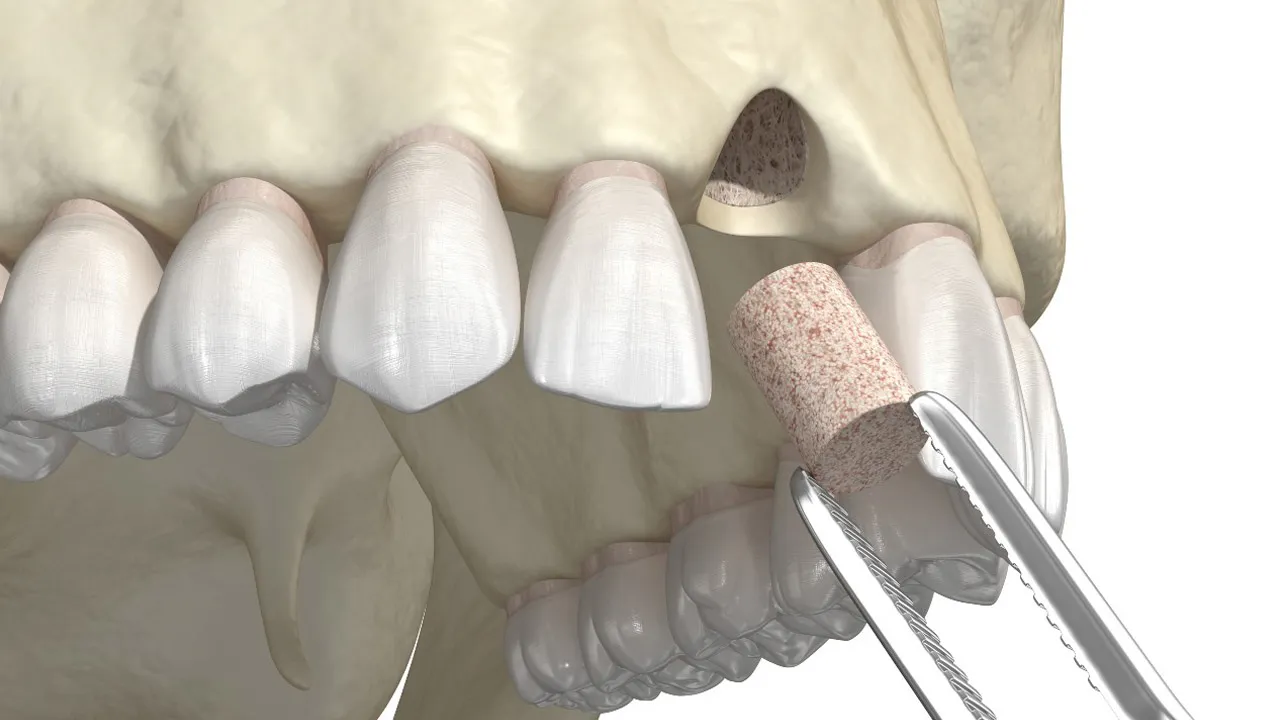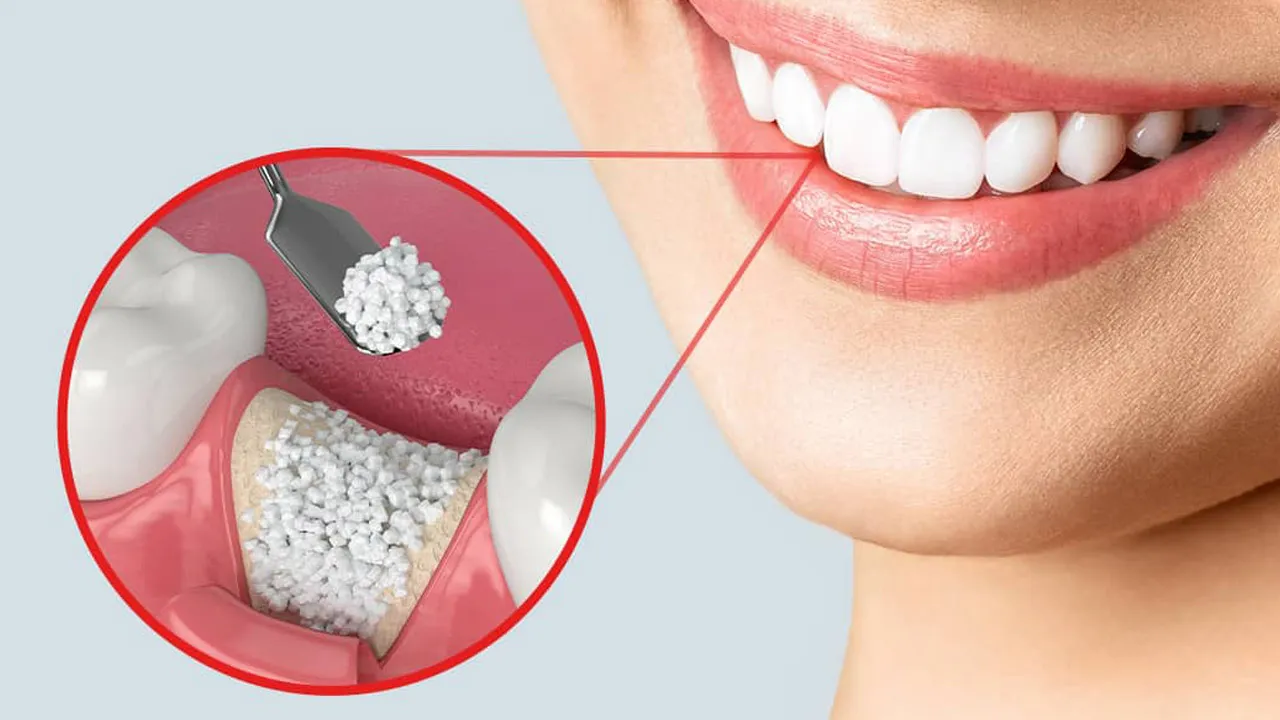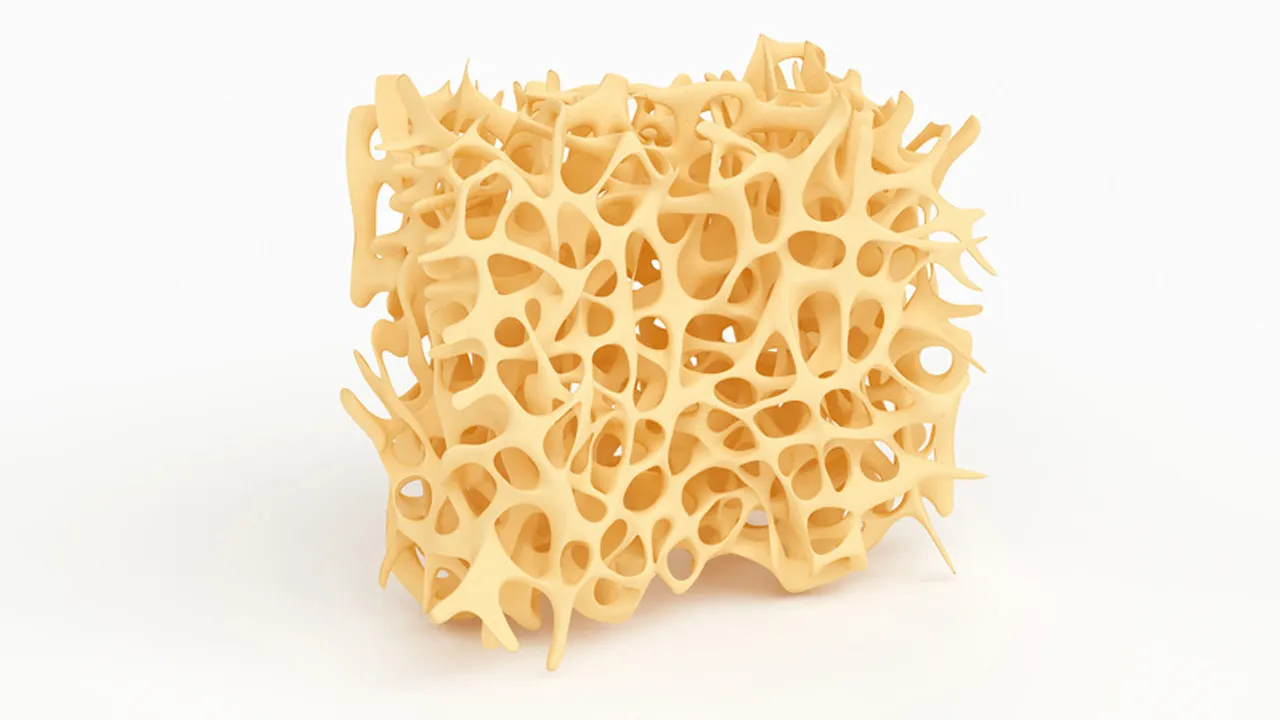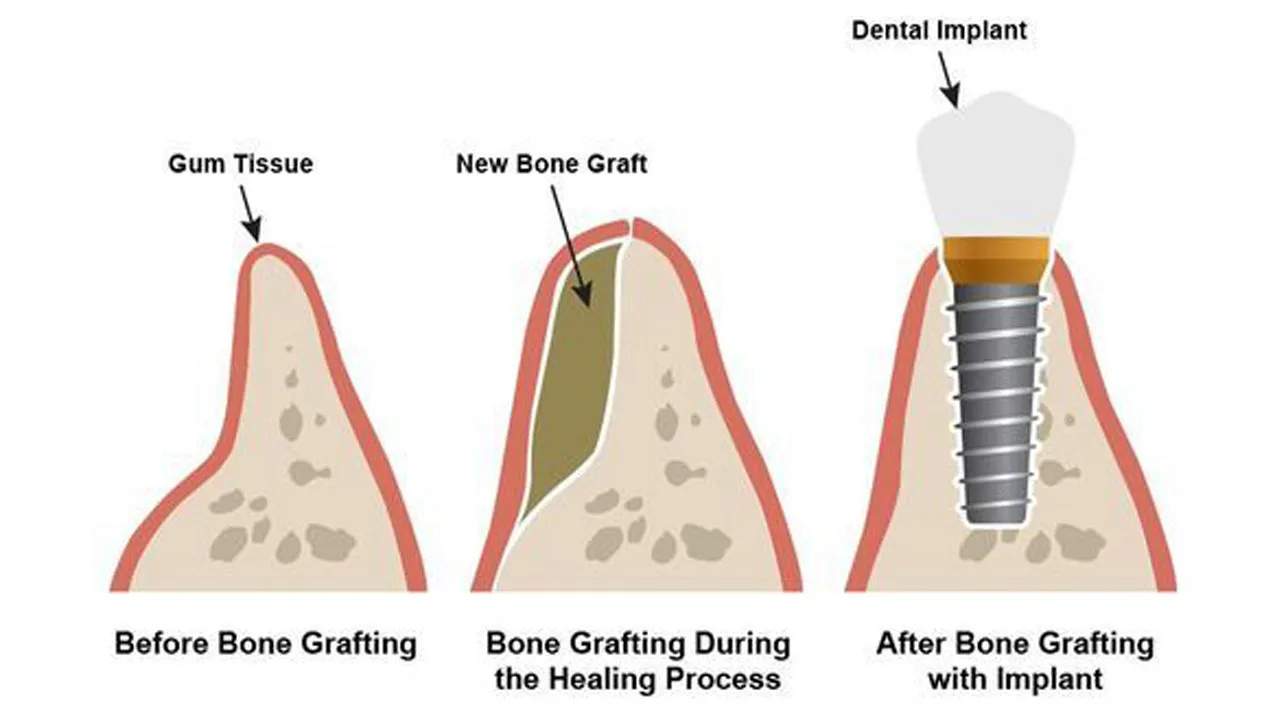Dental bone grafting is a process that is used to rehabilitate or reconstruct the jawbone in the areas where the absence of teeth. It is used to build the foundation needed to place dental implants, which supports the substitute teeth. There are various types of dental bone grafts that are utilized including autogenous bone grafts. The method involves utilizing the patient's own bone, frequently extracted from the chin, jaw, or hip, to reconstruct the jawbone. Another one is Allografts, which involves using donated human bone, normally from a tissue bank. Xenografts on the other hand involve using animal bone, typically from cows, to rebuild the jawbone. Alloplast includes utilizing manufactured materials, such as hydroxyapatite or tricalcium phosphate, to rebuild the jawbone.
The process of dental bone grafting frequently involves making an incision in the gum tissue to uncover the jawbone. The bone graft material is then set into the area and shaped to fit the defect or loss of bone. The incision is then secured with sutures, and the area is allowed to heal.
The healing duration for dental bone grafting depends on the type of bone graft used, the size of the area being grafted, and the individual's healing ability. Typically, bone grafting procedures take several months to fully heal. During this time, the patient may need to follow a soft food diet and avoid hard, crunchy, or sticky foods. The patient must avoid smoking or using tobacco products, and maintain a consistent oral hygiene regimen to avoid infection and promote healing. A follow-up appointment may be scheduled to track the progress of the healing and the healing duration is better discussed with the dental professional who performed the procedure.
What Is A Dental Bone Graft?
Bone grafting is a surgical procedure in which bone material is placed into an area of the body where the bone is missing, damaged, or has stopped growing. The goal of bone grafting is to provide the body with the necessary bone material to repair or rebuild damaged or missing bone.
There are several types of bone grafts that are used, including Autografts. These are bone grafts that are taken from the patient's own body. Commonly used sources include the hip, shinbone, and skull. Allografts: These are bone grafts that are taken from a donor. These are either cadaveric or from tissue banks. Synthetic grafts: Artificial materials that mimic natural bone, which include calcium phosphate, ceramic or hydroxyapatite-based products.
Bone grafting is commonly used in dental and orthopedic procedures, such as to repair jawbones damaged by trauma or infection, to promote merging in spinal surgery, to help heal fractures that are slow to heal, and to restore the height of a vertebra in the spinal fusion.
The history of bone grafting dates back to as early as the 1600s. The history of bone grafting dates back to ancient times when bone fragments were used to fill in gaps in the skull. The use of bone grafts for treating bone defects and injuries has evolved over time, with the development of new surgical techniques and materials.
In the late 1800s and early 1900s, bone grafting was primarily used for the treatment of fractures and injuries. Surgeons would use bone from the patient's own body, such as from the ribs or hip, to fill in defects or gaps in the bone. The discovery of antibiotics revolutionized bone grafting, as it made it possible to transplant bone from one person to another without the risk of rejection in the 1950s. It led to the development of allografts, which are bone grafts taken from donors.
Synthetic bone grafting materials were developed, such as hydroxyapatite and tricalcium phosphate, which have similar properties to natural bone and are used in various surgical procedures in the 1970s and 1980s.
The origins of bone grafting are traced back to ancient times, when doctors and healers used a variety of materials, such as animal bones and teeth, to fill in missing or damaged bones. In more recent history, the first recorded use of bone grafting in modern medicine was in the late 19th century, when Sir Hermann Weber, a German orthopedic surgeon, used a technique known as "cancellous bone transplantation" to repair fractures and other bone injuries.
The procedure involved using small pieces of bone from the patient's own body (typically from the hip or rib) to fill in the damaged area. In the 20th century, advancements in surgical techniques and the development of synthetic bone graft materials made the procedure more widely available and effective. The use of stem cells and growth factors in bone grafting has emerged as a promising technique to enhance bone regeneration in recent years. Furthermore, the development of new technology such as guided bone regeneration and platelet-rich plasma has made bone grafting procedures more precise and effective.
Bone grafting is primarily used by orthopedic surgeons and oral surgeons as part of the repair or rehabilitation of bones. These surgeons use Bone grafts in a variety of situations including fracture repair, joint replacement, Dental Treatment Implants, spinal fusion, reconstructive surgery, and trauma injury. Overall, bone grafting has evolved over time and continues to be an important area of research and development. The bone grafting techniques continue to be improved and new materials developed to enhance the effectiveness and outcome of these procedures.

When is Bone Grafting Needed?
Bone grafting is a surgical approach that is utilized to fix or regenerate injured or missing bone. It is usually executed when there is not sufficient healthy bone present to support the desired method, such as dental implants or spinal fusion. Whether a cavity has reduced the tooth to an empty space in the gum, or gum disease has developed a loose tooth, a bone graft is usually advised. Bone grafting is needed when there is a loss of bone mass or a structural defect in the bone.
Bone grafting is often used in a variety of medical and dental procedures, such as Dental implants. Bone grafting is used to build up the jawbone so that it supports dental implants. Another procedure where bone grafting is necessary is jaw reconstruction. Bone grafting is likely to be used to reconstruct the jawbone after an injury or infection. Spinal surgery uses bone grafting too. It is utilized to promote integration between the vertebrae in spinal surgery.
Fracture healing uses bone grafting to help heals fractures that are slow to heal or not healing suitably. During an Orthopedic surgery, a bone grafting procedure is likely to be utilized. In cases of joint replacement like knee or hip, the bone possibly has been damaged by arthritis or other conditions.
Sinus lift surgery utilizes bone grafting. Bone grafting is done to build up the jawbone in the back of the upper jaw in order to place dental implants. Consulting with a skilled surgeon or dental specialist is smart to determine whether bone grafting is needed in a certain case and the suitable method to use. The suitability of the bone grafting method depends on the individual case and the medical history and state of the person.
Is Bone Grafting safe?
Yes, bone grafting is safe. Bone grafting is generally safe and has become a reliable, minimally-invasive procedure for those seeking to restore the bone structure or fix bone fractures. In fact, there have been remarkable successes in cases involving severe bone loss due to disease, trauma, or congenital defects. Of course, as with any medical procedure, there are always risks involved, but they are likely to be minimized with appropriate preoperative planning and postoperative care. Additionally, by carefully monitoring the healing process and making necessary adjustments along the way, patients are assured that their treatment plan is going to provide an optimal outcome.

What are the Types of Bone Grafting?
There are several types of bone grafting used by medical professionals. Some use synthetic materials while others prefer natural ones, especially coming from the same individual that of own body.
Listed below are Types of Bone Grafting
- Xenograft Tissue: Xenograft tissue is taken from a donor of a different species, typically a cow or pig. It is widely available and has a high success rate, but there is a small risk of disease transmission from the donor tissue.
- Alloplast Bone Graft: Alloplast bone grafts are made from synthetic materials and are designed to mimic the structure and function of natural bone. They are widely available and are produced in a variety of shapes and sizes to suit the specific needs of the patient.
- Autograft Tissue: Autograft tissue is extracted from the patient's body and is normally obtained from a donor site such as the hip or the chin. Autograft tissue is the most biologically active and has the highest success rate of all types of bone grafting material.
- Allograft Tissue: Allograft tissue is taken from a donor of the same species but is unrelated to the patient. It is typically obtained from a tissue bank and is carefully screened and processed to reduce the risk of disease transmission.
1. Xenograft Tissue
Xenograft tissue bone grafting is a type of bone grafting procedure that involves using bone tissue from a donor of a different species, usually a cow or pig, to repair or augment the patient's own bone. Xenograft tissue is often used in situations where the patient's own bone tissue is not accessible or is not sufficient for the bone grafting process. Xenograft tissue has several advantages over other types of bone grafting material. It is widely available, easy to handle, and has a high rate of success. It is even relatively inexpensive compared to other types of bone grafting material. However, there are some potential downsides to using xenograft tissue. One worry is the likelihood of transferring disease from the donor tissue, although the risk is regarded as low. Furthermore, xenograft tissue is less biologically active than the patient's own bone tissue, which affects the rate of bone healing and remodeling. Overall, xenograft tissue is a helpful option for bone grafting in certain situations, but it is essential to discuss what is xenograft tissue and the potential risks and benefits with a healthcare provider before deciding on this type of treatment.
2. Alloplast Bone Graft
Alloplast bone grafts are a type of synthetic bone graft material that is made from man-made materials rather than natural bone tissue. Alloplast bone grafts are designed to mimic the structure and function of natural bone and are used in a variety of surgical procedures, including dental implant procedures. Other people are not quite familiar with it and are likely to ask what is alloplast bone graft. Alloplast bone grafts are likely to be made from hydroxyapatite. Hydroxyapatite is a synthetic bone graft that is widely used now because of its hardness, osteoconduction, and acceptability by the bone. Other synthetic bone grafts are made of calcium carbonate. However, they are not commonly used at the moment because it makes bone breakage easier.
3. Autograft Tissue
Autograft tissue is a kind of bone graft material that is extracted from the person's own body. Autograft tissue is normally obtained from a donor area on the patient's own body, such as the hip or the chin, and it is used to repair or augment bone in a different area of the body. Autograft tissue has a number of advantages over other types of bone graft material. Some people are not familiar with what is autograft tissue. It is the most biologically active type of bone graft material and has the highest rate of success. It is less likely to be rejected by the body, as it is taken from the patient's body. However, there are some potential disadvantages to using autograft tissue. One concern is that obtaining the tissue from a donor site is correlated with extra surgical operations and probable after-effects, such as scarring and pain. Furthermore, the availability of autograft tissue may be limited, as it depends on the size and location of the donor site. Overall, autograft tissue is by and large regarded as the gold standard for bone grafting procedures due to its high rate of success and low risk of rejection. However, it is essential to discuss the probable concerns and benefits with a health professional before deciding on this type of treatment.
4. Allograft Tissue
Allograft tissue is a type of bone graft material that is taken from a donor of the same species but unrelated to the patient. Allograft tissue is typically acquired from a tissue bank, where it is carefully screened and suitable beforehand to reduce the risk of transferring a certain disease. Allograft tissue has several advantages over other types of bone graft material. To answer what is allograft tissue, it is widely accessible and is produced in a selection of shapes and sizes to suit the certain needs of the patient. Allograft tissue is relatively easy to handle and easily manipulated during surgery. However, there are some probable disadvantages to using allograft tissue. One concern is the possibility of spreading disease from the donor tissue, although this risk is considered to be low due to the screening and processing measures that are in place. Besides, allograft tissue is likely to be less biologically active than the patient's own bone tissue, which impacts the rate of bone healing and remodeling.
Which is the most commonly used type of Bone Grafting?
Autograft is the most regularly used type of bone grafting due to its great success rate. However, in certain situations, it may not be possible or practical to use autograft tissue. For example, if the patient does not have sufficient bone tissue at hand or if the donor site is not suitable, other types of bone grafting materials are utilized. Allograft tissue (extracted from a donor of the same species) or xenograft tissue (extracted from a donor of a separate species) is possibly used in such cases. Alloplast bone grafts, which are built from synthetic materials, are likely to be used in some cases.
The most regularly used type of bone grafting material depends on the specific situations of the patient and the surgical procedure being done. Different types of bone grafting materials are more suitable for different circumstances. Ultimately, the most suitable type of bone grafting material depends on the specific needs and circumstances of the person, and it is essential to discuss the alternatives with a healthcare provider before deciding on a treatment plan.
What is the Process of Bone Grafting?
The process of bone grafting differs depending on the variety of bone grafts being used and the location and condition of the area being grafted. But in the majority, the process of bone grafting includes following some steps. The first step is planning and preparation. The surgeon or dental specialist is going to review the patient's medical history, performs a physical examination, and take imaging studies, such as X-rays or CT scans, to establish the location, size, and condition of the area that is in need of a bone graft.
Second, the medical professional is going to administer anesthesia. Bone grafting procedures are typically performed under general anesthesia or local anesthesia with IV sedation. The type of anesthesia used depends on the size and location of the area being grafted and the patient's preferences.
The third is the Incision and exposure of the area. The surgeon or dental specialist is going to make an incision in the skin or gum tissue to examine the area that requires a bone graft.
The fourth step is the grafting material placement. The bone graft material is placed into the area once the area is accessed. It is shaped as needed and held in place with screws, plates, or other fixation devices.
The fifth step is the closure of the wound. The incision is then closed with sutures or staples. A dressing is then applied to protect the surgical site.
Lastly is recovery. Patients need to rest and avoid any strenuous activities following the procedure, depending on the process. They are given instructions on how to care for the surgical site and take any prescribed treatments. It's important to follow the instructions attentively to promote healing and reduce the risk of complications.
Keep in mind that the recovery time after a bone grafting procedure differs depending on the type of procedure, the patient's complete health, and the extent of the injury or damage. Generally, it takes several months for the grafted bone to fully integrate with the adjoining bone, and for the area to fully heal.
Are there risks to Bone Grafting?
Yes, there are risks to bone grafting. Bone grafting is a surgical method that entails using bone from one area of the body to repair or rebuild bone in another area of the body. It is normally used in an orthopedic operation, oral surgery, and dental implant procedures. While bone grafting is widely regarded as safe. However, there are some risks involved with the procedure. Some of the most known risks involved with bone grafting include infection. There is a small risk of infection after a bone graft, which is usually treated with antibiotics. However, in some cases, the infection is possibly severe and requires additional surgery to clean out the infected area.
Blood loss is a potential complication of bone grafting procedures, as with any surgical procedure. The amount of blood loss depends on several factors, including the type of bone grafting procedure being performed, the size of the area being grafted, and the individual's overall health. A patient is likely to lose some blood, however, The amount of blood loss is minimized by the use of modern surgical techniques, such as utilizing tourniquets, electrocautery, or laser-assisted surgery during the procedure. These techniques are designed to minimize bleeding and improve visibility during the procedure. Some minor bleeding and/or swelling is to be expected after the procedure. The bleeding is controlled with pressure and/or sutures and usually subsides within a few days after the procedure in most cases.
How long is the Healing Process of Bone Grafting?
The complete healing process of bone grafting is likely to take between three and nine months. The length of time it takes to recover from a dental bone graft procedure varies depending on the specific circumstances of the patient and the type of bone grafting material used.
In general, most patients expect to experience some swelling, bruising, and discomfort for the first few days after the procedure. The patient's mouth is likely to be numb following the procedure, as a local anesthetic is typically used during the procedure. It is essential to follow the healthcare provider's instructions for pain management and post-operative care to help ensure a smooth recovery.
Most patients return to their normal activities within a few days after a dental bone graft procedure. However, it is important to avoid strenuous activities and to follow any specific instructions provided by the healthcare provider, such as avoiding certain foods or avoiding the use of tobacco products.

Are there factors that affect the Healing Process of Bone Grafting?
Yes, there are factors that influence the healing process of bone grafting. Some component includes the overall health condition of a patient, their way of living, and their age. People in excellent health state have a better prognosis for healing after bone grafting. Age is definitely one big factor when it comes to bone grafting. Older patients are likely to have a slower healing approach due to decrease blood flow and weaker immune systems.
An unhealthy lifestyle is likely to contribute to the slow healing process of bone grafting, particularly smoking. Smoking negatively impacts the healing process by reducing the blood flow to the section and decreasing the oxygen level reaching the bone. The overall health conditions of a person are among the factors that affect success of dental implant.
How Painful is Bone Grafting procedure?
Someone is likely to feel some pressure or discomfort, but it should not be unbearable during the bone grafting procedure. Bone grafting is a surgical method that involves transplanting bone tissue to an area where there is a deficiency or loss of bone. The procedure is used to repair bones that have been damaged by injury or disease or to prepare the site for dental implant placement. The level of pain associated with bone grafting is not the same depending on the type of procedure being executed and the individual's pain tolerance.
Some people experience only mild discomfort during the procedure, while others experience more significant pain. The surgical area is going to be numbed with a local anesthetic. For instance, if a large area needs to be grafted, or if the patient has a low pain tolerance, a general anesthetic may be used. Post-operative pain is manageable with over-the-counter pain medication, or prescription medication if needed. There is likely to be some swelling, redness, and mild discomfort for a few days after the procedure.
There are different types of bone grafts that are done depending on the case. Some are more invasive than others. If the bone deficiency is minor and not much bone is needed, a small incision is done and the bone is placed directly into the area. A bone graft must be taken from the patient's own body, often the hip for more severe bone loss. This is called autograft. This procedure is generally more invasive than other types of bone grafting and is likely to be more painful. Overall, the procedure is considered to be relatively safe and most people recover well.
The dental surgeon is going to give patients specific instructions on how to care for themselves after the procedure, and they are the best person to tell them what to expect. It's important to follow all of the instructions provided by the surgeon to ensure the best outcome from the bone grafting procedure, and to minimize the risk of complications or additional pain.
How much does Bone Grafting cost in Turkey?
The average cost of simple bone grafting ranges from $130 to $800 for each implant section using a synthetic bone in Turkey. However, the cost of bone grafting in Turkey differs depending on a number of factors, such as the type of bone grafting material used, the bone graft's location, and the procedure's overall complexity. There are several factors that influence the cost of a bone grafting procedure.
Type of bone graft: The cost of a bone grafting procedure varies depending on the type of bone graft being used. Autografts, which involve using the patient's own bone, are likely to be more expensive than allografts, which use donated bone, and synthetic grafts.
Location of the procedure: The cost of a bone grafting procedure varies depending on where it is being performed. The cost may be higher in an urban area compared to a rural area, or in a private clinic compared to a hospital.
Experience of the surgeon: The cost of a bone grafting procedure varies depending on the experience and qualifications of the surgeon or dental specialist performing the procedure.
Health insurance: The coverage of insurance greatly affect the cost as private health insurance would cover part or all of the cost.
The complexity of the surgery: The cost of a bone grafting procedure differs depending on the complexity of the surgery, such as whether additional procedures are required, or the condition of the area being grafted.
Is the success rate of Bone Grafting High?
Yes, bone grafting has a high success rate. The success rate of the bone grafting process varies and it has something to do with the specific kind of bone graft, the position and condition of the area being grafted, and the complete health and healing abilities of the individual. Generally, bone grafting procedures have high success rates, with many patients experiencing improved bone density and the development of new bone tissue in the grafted region. A composite bone graft has a 99.6% survival rate and a success rate of 66.06%. Nonetheless, there are some cases when bone grafts fail and need to be redone, but these are rare.
Is having a healthy jawbone necessary for Bone Grafting?
Yes, having a healthy jawbone is ultimately required for successful bone grafting. Bone grafting is a surgical procedure that involves adding new bone to a region of the jaw that has lost bone due to injury, disease, or other factors. The new bone is usually extracted from another area of the body (such as the hip or chin) or a tissue bank, and it is placed in the jaw to help hold up the positioning of a dental implant or other kinds of dental restoration. For the bone graft to be efficient, it is vital that the jawbone is healthy enough to support the new bone. For instance, if the jawbone is severely damaged or diseased, it is not able to support the bone graft, and the operation is not likely to be successful. In such cases, additional treatments are necessary to improve the health of the jawbone prior to bone grafting being executed.
Is the extraction of Bone Grafting painful?
No, the bone grafting procedure is not painful. The procedure is done while the patient is under anesthesia. However, after the operation, there is some usual discomfort like bleeding, swelling, and bruising. The location of the bone graft sometimes affects the level of pain in some. Bone grafts are taken from different body areas, and some locations are more sensitive than others. For instance, bone grafts taken from the chin or hip are less painful than those taken from the back of the jaw. Generally, the pain associated with bone grafting is usually manageable and controlled with proper pain management.





